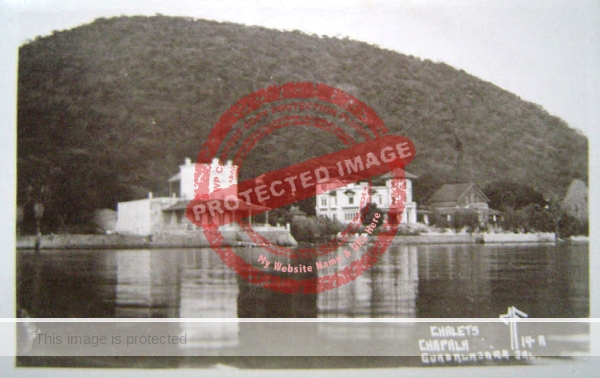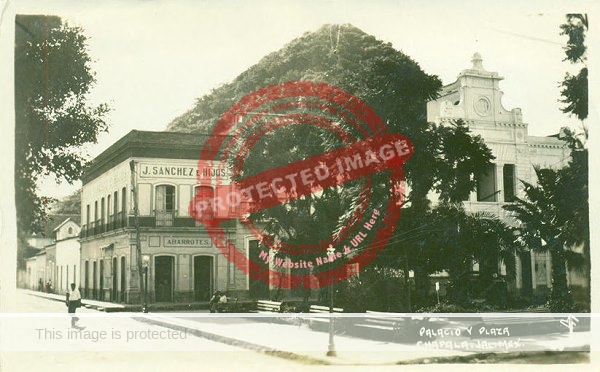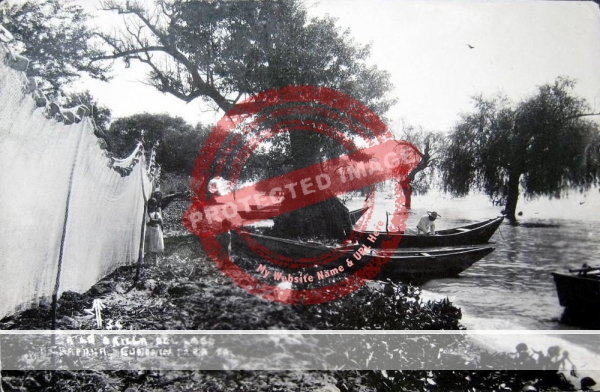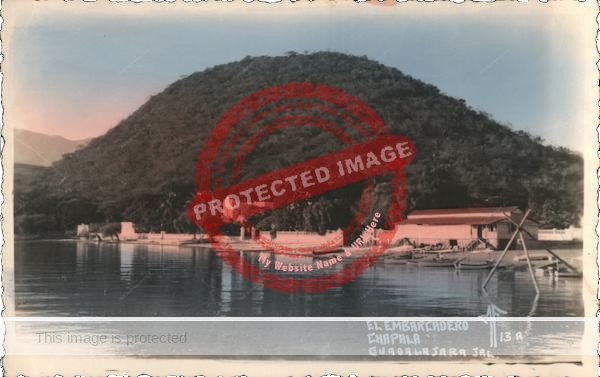Among the many early postcards of Lake Chapala that were published in Mexico City are several labeled with a caption and stylized “MF” logo. These cards were produced and distributed by México Fotográfico, a Mexico City firm founded by Demetrio Sánchez Ortega. Sánchez Ortega himself took many of the photographs used for the company’s early cards and may have taken this view of the shoreline in Chapala with its distinctive “chalets”. The three most prominent buildings nestled beneath Cerro San Miguel in this image are (from left to right) Villa Elena, Villa Niza and Villa Josefina.

México Fotográfico. c 1930. (l to r) Villa Elena, Villa Niza and Villa Josefina.
Demetrio Sánchez Ortega was born in Huatusco, Veracruz, on 22 December 1898. He moved to Mexico City in search of work as a young man and took a job selling paper before finding work as a traveling agent for the Cervecería Moctezuma brewery. This position involved traveling to bars (cantinas) all over the country, where he would perform simple sleight-of-hand and magic tricks, using cards, bottles and simple props, all designed to boost the sales of the brewery’s XX beer brand.
During these trips he must have come across (and maybe relied on) existing illustrated tourist guides, just as he surely encountered postcards published earlier by the likes of Hugo Brehme, Alfred Briquet, William Henry Jackson and Charles B. Waite.
The knowledge, experience and connections that he built up during his travels served him well when he decided to become a photographer. Introduced to photography by a friend, and almost entirely self-taught, Sánchez Ortega founded México Fotográfico, located on Calzada de Guadalupe in Villa de Guadalupe in Mexico City, in 1925, a year after Plutarco Elías Calles became president. Some sources suggest he had government support. México Fotográfico, like several other postcard publishers, became an important pillar of Mexico’s promotion of tourism.

México Fotográfico. c 1945 (?). Former Chapala plaza and Presidencia Municipal.
The view of downtown Chapala (above) shows the plaza in its pre-1950s location and the former Presidencia Municipal.
México Fotográfico was very much a family business. Sánchez Ortega and his wife, Tomasita Pedrero, had five children—Alfredo, Eustolia, Teresa, Demetrio and Alfonso—all of whom worked at one time or another in the laboratory and printing side of the business.
Later, the sons became traveling photographers. The company employed a number of “traveling agents”, responsible for photographing the places they visited while promoting the company, taking orders and arranging the distribution of postcards.

México Fotográfico. c 1950. Chapala lakeshore.
This card (above), showing the lakeshore, trees and fishing nets, and believed to date from the 1950s, was a popular choice as a memento of a trip to Lake Chapala.
Over the years, México Fotográfico amassed an extensive and culturally-rich collection of landscapes and towns large and small all over the country. The collection includes more than 25 cards related to Chapala, and an additional 10 cards of Ocotlán. Several of the cards were reissued in a colorized edition with crenulated edges, and the firm published at least one multi-view card of Chapala, with small reproductions of six photographs in the series.

México Fotográfico. c. 1935? Main beach, Chapala.
The company’s longevity (it was still producing cards into the 1970s) meant that its corpus of work provides a valuable visual record of the changes in towns, people and customs across post-revolutionary Mexico.
The Mexico City daily, Excelsior, had introduced a weekly supplement—Jueves en Excelsior—in 1923. Photographs published by México Fotográfico were used occasionally as illustrations in 1926. In 1927, the two companies began a much closer relationship, with México Fotográfico supplying many of the photos used in the supplement, perhaps in exchange for small display ads. The earliest such ad, in May 1927, had a portrait of Sánchez Ortega and the text “Fundador gerente de la negociación México Fotográfico, establecida en Guadalupe Hidalgo, México, DF”.
México Fotográfico was active from the 1920s into the 1970s. Its founder, the beer-parlor magician Demetrio Sánchez Ortega, master of postcard illustration, gradually lost his sight and had become completely blind by the time of his death on 27 January 1979.
Acknowledgments
My thanks to Manuel Ramirez for responding to a query posted on Facebook asking which postcard publisher utilized the MF logo.
This profile is based almost entirely on the extensive research by Mayra N. Uribe Eguiluz for her 2011 thesis on the company for a Masters degree in Art History at the National University (UNAM) and her related article in Alquimia, referenced below.
My 2022 book Lake Chapala: A Postcard History uses reproductions of more than 150 vintage postcards to tell the incredible story of how Lake Chapala became an international tourist and retirement center.
Note: This post was first published 29 July 2019.
Sources
- Arturo Guevara Escobar. 2011. Letra: M. “Fotógrafos y productores de postales.” Originally published 19 November 2011.
- Ariel Gutiérrez. 2015. “México Fotográfico II.“. Blog post dated 30 June 2015.
- Jueves de Excelsior: 12 May 1927.
- Mayra N. Uribe Eguiluz. 2011. “La Compañía México Fotográfico en la política de turismo nacional de los años veinte.” Alquimia 42 (2011), 22-29.
Comments, corrections or additional material related to any of the writers and artists featured in our series of mini-bios are welcomed. Please use the comments feature at the bottom of individual posts, or email us.
Tony Burton’s books include “Lake Chapala: A Postcard History” (2022), “Foreign Footprints in Ajijic” (2022), “If Walls Could Talk: Chapala’s historic buildings and their former occupants” (2020), (available in translation as “Si Las Paredes Hablaran”), “Mexican Kaleidoscope” (2016), and “Lake Chapala Through the Ages” (2008).
Wow–it would have been hard travel but I wish I’d seen the Mexico of those times–thanks again for another enjoyable presentation.
Yes, traveling in those days must have been quite an ordeal. Thanks for your continued support.